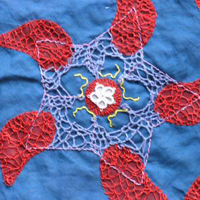Designs for Life
"Designs for Life" was an art/science collaboration, funded by The Wellcome Trust, and co-ordinated by The Oxford Trust in collaboration with Diamond Light Source, the UK's national syncrotron, and Oxfordshire Womens Institute.
The project was launched on 2nd March 2006. Over 150 women from Oxfordshire Women's Institutes worked on ideas for the pieces in response to a discussion and debate surrounding the funding and study of diseases, drug development and environmental health all of which relate to the biosciences researched at the Diamond Light Source. In total thirty 50cmsx50cms were constructed from hand dyed fabric and yarn using a variety of patchwork, quilting, hand and machine embroidery, tatting, knitting, crochet and weaving techniques. These were hung either side of the main staircase in the atrium. Architect image courtesy of JacobsGIBB Ltd / Crispin Wride Architectural Design.
The project was supported by Hugo Brunner, Lord Lieutenant of Oxfordshire and inspected by HM The Queen on the opening of the facility.


Diffraction Patterns
A diffraction pattern is caused when a beam of intense light bends around an obstruction. By observing these patterns, in experimental stations known as beamlines, it is possible for the scientists at Diamond to analyse the structure of microscopic particles and to reveal new information in support of the life, physical and environmental sciences.
Designs by Anne Griffiths
Made by members of the WI's Home and Garden committee
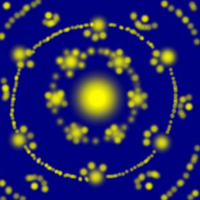
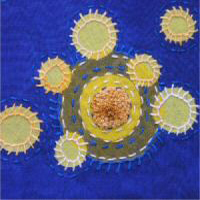

Made by staff at Diamond Light Source
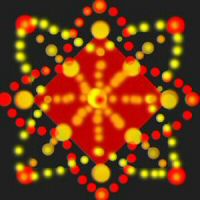

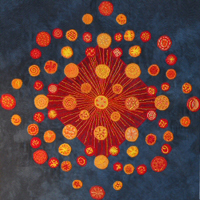
Photosynthesis
Using sunlight to power our homes and offices is still largely a dream since solar cells remain inefficient and expensive. Studying how plants absorb sunlight during photosynthesis and transform it into the energy they need could help provide clues to building better solar cells.
The complete protein image is shown courtesy of Wellcome Trust

Design by Anne Griffiths
The initial stitch for this group panel was put in by the Oxfordshire Federation Chairman Pauline Goddard at the Weston-on-the-Green group meeting on 26th April 2006. By the end of the project over 1000 members of Diamond Light, Oxfordshire WI's, friends and families had contributed at least one stitch to this panel



Protein Helix
Another portion of the protein is depicted below.
Design by Anne Griffiths
Made by Bodicote WI, Little Compton WI, Over Norton WI and Salford WI
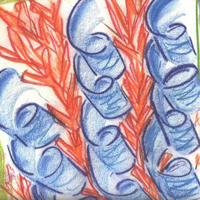
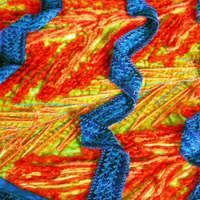
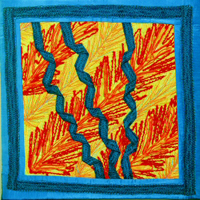
Molecular Structures
A drug is made up of several elements, usually carbon, hydrogen and oxygen. These elements are stuck together by bonds in various ways and quantities to make up each specific drug. Scientists represent drugs using a ball and stick diagram, the ball or circle is the element, coloured to show the element it represents, and the stick is the bond. The velvet circles in this panel represent red-oxygen, yellow-sulphur grey-carbon white-hydrogen and blue-nitrogen.
Design by Anne Griffiths
Made by Langford Village WI

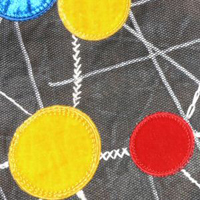
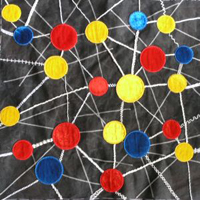
DNA
DNA (Deoxyribonucleic acid) contains the genetic instructions for the biological development of each cell within a person's body. All known cellular life and some viruses contain DNA. Structurally, DNA is a double helix, two strands of genetic material spiraled around each other, each strand containing a sequence of chemicals (adenine, guanine, cytosine and thymine). These chemicals are common to everyone, however it is the sequence in which they are put together that makes each person's DNA unique. The fact that DNA is unique from person to person (unless you have an identical twin) is vital when it comes to DNA fingerprinting. DNA fingerprints can be used for anything from determining a person's biological parent, the diagnosis of inherited disorders, or for identifying the suspect of a crime.
Design by Anne Griffiths
Made by Stoke Row WI, South Stoke WI, Goring and Woodcote WI

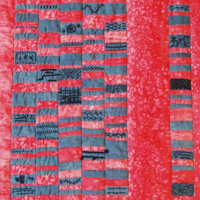
Dementia
Alzheimer's disease is a progressive brain disorder that gradually destroys a person's memory and ability to learn, reason and communicate. People affected can also experience distressing changes in their personality and behaviour. The number of people with Alzheimer's disease is set to triple in the next 30-40 years as the average age of the global population soars.
Creutzfeldt-Jakob disease (CJD) is a prion disease which is a rare and fatal form of dementia that occurs in individuals between 40 and 80. However, in 1996 a new form of CJD (vCJD) prevalent in younger people was identified. Amyloid plaques such as those found in Alzheimer's patients can also be found in BSE and CJD victims.
More information and help on coping with Alzheimer's can be found on http://www.alzheimers.org.uk .
Brain
Brain scans are used in the diagnosis of dementia. Computerised Tomography (CT) and Magnetic Resonance Imaging (MRI) are two types of scan that generate images of the internal structure and condition of the brain. Coloured areas of the brain show differences in brain activity, appearance and metabolism.
Design by Anne Griffiths
Made by Begbroke WI and Filkins WI



Amyloid plaques
Amyloid plaques are aggregates of misfolded proteins that form in the spaces between nerve cells. These abnormally configured proteins are thought to play a central role in Alzheimer's disease. The amyloid plaques first develop in the areas of the brain concerned with memory and other cognitive functions.
Design by Anne Griffiths
Made by Letcombes WI, Charlton WI, King Alfred's WI and Stanford in the Vale WI
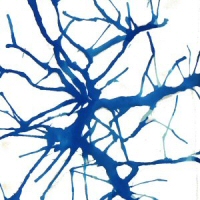
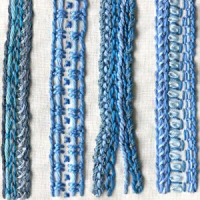

Design by Anne Griffiths
Made by Stoke Lyne WI and Bucknell WI

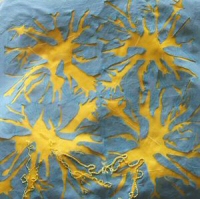

Tangles
In addition to Amyloid plaques, structures known as Tangles are also found in Alzheimer's suffers. These are twisted strands of a different protein that form inside the brain cells. It is unknown at this stage whether these structures cause Alzheimer's or are a by-product of a different process is undiscovered at the time of writing.
Design by Anne Griffiths
Made by Charlton WI, Wantage WI and The Letcombes WI

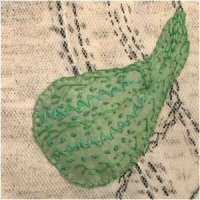
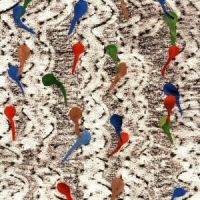
Design by Cherwell Valley College
Made by Shipton under Wychwood WI


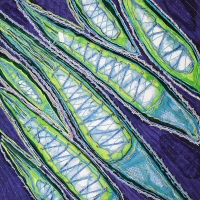
BSE and CJD
Bovine Spongiform Encephalopathy (BSE) is a is a type of prion disease that affects the brains and central nervous system of adult cattle. It is caused due to a build-up of abnormal prion proteins. This accumulation causes the brain to shrink and deteriorate giving it a spongy appearance. Symptoms include disorientation, clumsiness and aggressive behaviour.
For more information on BSE see http://www.food.gov.uk/bse and for CJD http://www.cjdsupport.net
Design by Anne Griffiths
Made by Watlington WI, Otmoor WI, Chalgrove WI, Waterstock and Tiddington WI, Benson WI and Cuddesdon and Denton WI

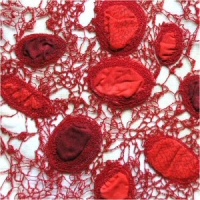
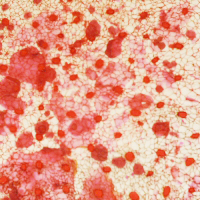
Malaria
Malaria causes around 2.5 million deaths around the world every year, most of them in children under 5.It is caused by a parasite, which is transmitted to humans by the female Anopheles mosquito. When the mosquito bites a human, the parasite is injected into a red blood cell. Inside the red blood cell the parasite replicates, swelling the cell until it finally bursts releasing the parasite into the bloodstream where it infects other cells. Symptoms include bouts of chills and fever and in some cases, death.
This panel shows the life cycle of the malaria virus.
Design by Anne Griffiths
Made by Bodicote WI, Little Compton WI, Over Norton WI and Salford WI
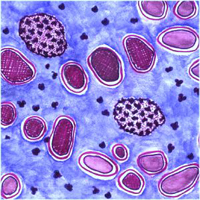
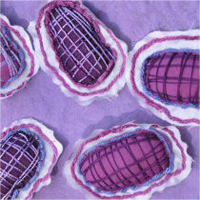
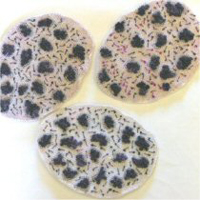
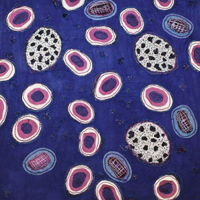
Environment and Allergic Diseases
Pollution is not only bad for the environment, but it can have serious effects on human health. Chronic conditions such as asthma can be worsened by environmental pollution. Recent research also shows that multiple sclerosis could be linked to difficulties in processing iron and aluminium. By looking at the chemicals inside polluted soils, plants and water, scientists can understand how they are released into the environment, and also how they can be mopped up again. Pollen Allergic diseases, such as hay fever and conjunctivitis, are caused when a person is over sensitive to a particular substance. People can be allergic to wide range of things including environmental pollutants or pollen. This panel depicts pollen from the Acacia which can cause symptoms varying from a runny nose and rashes to the more dangerous anaphylactic shock.
Pollen
Design by Anne Griffiths
Made by Chilton WI


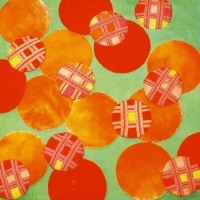
Aspergillus
Aspergillus is a group of moulds (fungus), which is found world-wide but especially in the autumn and winter in the Northern hemisphere. The mould grows on decaying vegetation, such as compost heaps and fallen leaves. It can also be found in air conditioning systems and hospitals. Only a few of these moulds can cause illness in humans and animals. Most of us are naturally immune and do not develop diseases caused by Aspergillus. However, when disease does occur, it takes several forms. Some people with asthma are allergic to the fungal spores which can trigger an attack if they are inhaled. Others will develop a condition known as Allergic Bronchopulmonary Aspergillus (ABPA), in which asthma worsens significantly, as a result of increased lung inflammation. Diseases caused by Aspergillus are called Aspergillosis. The severity of which is determined by various factors but one of the most important is the state of the immune system of the person.
Design taken from an image curtesy of Wellcome Trust
Made by Dunsden WI, Greys WI, Peppard and Stoke Row WI
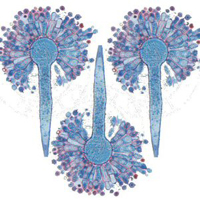



Osteoporosis
Osteoporosis, or porous bone, is a disease characterized by low bone mass and structural deterioration of bone tissue, leading to bone fragility and an increased susceptibility to fractures of the hip, spine, and wrist. Men as well as women suffer from osteoporosis, a disease that can be prevented and treated.
Design by Anne Griffiths
Made by Chadlington WI
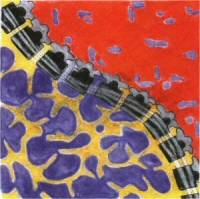


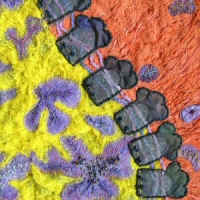
Design by Maureen White and Jane Madden
Made by Wolvercote WI and Marston WI


Cancer
Rates of breast cancer in the UK are still rising despite much better prognosis and treatment, with around 40,000 new cases of breast cancer diagnosed each year. About a fifth of breast cancers are linked to a gene called HER2. If this gene alters inside normal cells, it can trigger excessive growth causing a particularly aggressive form of cancer.
The new anti-cancer drug Herceptin is said to halve the chances of this type of cancer recurring. It is currently licensed for women with advanced breast cancer but has not yet been approved for women in the early stages. Herceptin has been linked to heart problems and costs around £20,000 for a year's treatment.
Breast Cancer
This panel represents the ravages of breast cancer on normal cells.
Design by Denise Greyburn
Made by Chalgrove WI and Otmoor WI
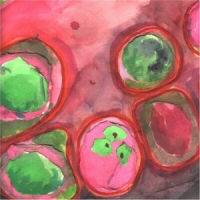

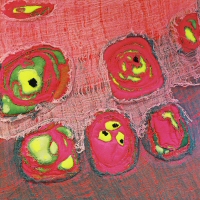
This panel shows a single breast cancer cell as it looks under a scanning electron microscope.
Design by Michele Tootell
Made by Weston on the Green WI, Begbroke and Stanton St John WI


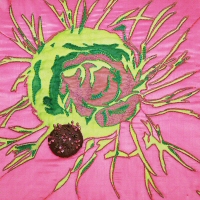
Cancer Chromosome
DNA is a very long continuous strand, which has to be packaged so that it fits into the nucleus of a cell. This packaged DNA is called a chromosome.
This panel uses knitting to illustrate this process. A long continuous strand of wool is 'packaged' by knitting to form a more compact shape. The variety of colours and textures representing the chemical components of the DNA.
Design based on photo courtesy of Wellcome Trust
Made by Chalgrove WI, Waterstock and Tiddington WI, Benson WI and Cuddesdon and Denton WI



Influenza
Influenza is a viral disease, symptoms are similar to those of a cold, aching muscles, headaches, fever, high temperature but are usually much worse leaving the sufferer bed ridden for several days. In certain individuals such as the elderly, and those with low-immunity the flu can be very serious and lead to pneumonia. For more information see: http://www.medinfo.co.uk or http://www.cdc.gov web.uct.ac.za
Flu Cross Section
The design below shows a cross section of one of the flu viruses, the 'pins' known as receptors attach themselves to cells in the body. All viruses have a similar construction but it is important to understand the precise structure of each virus in order to develop drugs to combat the disease.
Design by Anne Griffiths
Made by Filkins and Standlake WIs



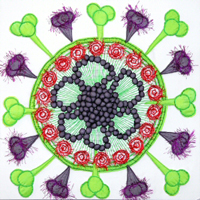
Virus Design
This panel shows several flu viruses based on an image of the virus under a microscope. It is stitched on a grey scollata background with green organza laid over the top. The flu virus has many receptors represented here by Dorset buttons that enable the virus to attach themselves to cells in the body.
Design by Anne Griffiths
Made by Marcham WI and Botley WI
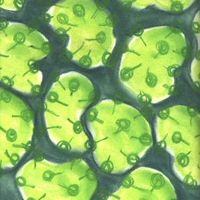
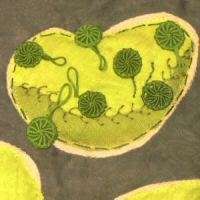


Influenza Infection
This final image of the flu virus, shows, in blue, the viruses attaching to the cells of the upper respiratory tract and infecting cells of the trachea. Viruses floating in the air are breathed in and bind to the hair-like microvilli and cilia on the surface of the cells that line the trachea. They then enter the cells and start to proliferate eventually causing the cells to die and the symptoms of the disease to become apparent.
Design taken from an image curtesy of Wellcome Trust.

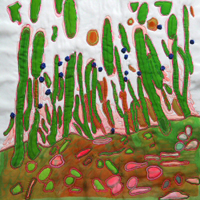
Aids
HIV is a virus that attacks the immune system. Therefore our immune system cannot kill HIV as it would other viruses. However when one develops an immune response, the virus is able to mutate quickly and easily, to evade this immunity. A person who has had the HIV infection for several years (10 on average, less in poorer countries) and has become ill with a number of severe illnesses is said to have AIDS. See http://www.avert.org
Virus Designs
These designs represent the AIDS virus and specifically the receptors. Accessing the receptors allows viruses to bind to other cells and to begin the cycle of infection.
Design by Anne Griffiths
Made by East and West Hendred WI and Chilton WI


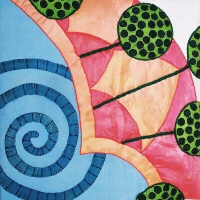
Design by Anne Griffiths
Made by Bloxham WI, Bodicote WI and Over Norton WI
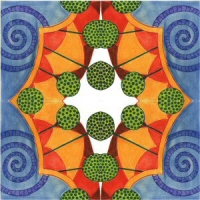

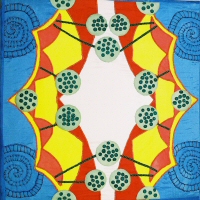
HIV Crystals
This design was inspired by an image of AZT crystals. The HIV virus replicates rapidly and drugs like AZT act by slowing down this replication and therefore the amounts of the virus present in the body.
Design by Cherwell Valley College
Made by Sutton Courtenay WI

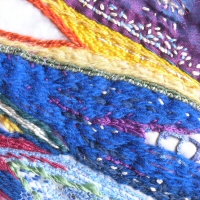

Protein Coat Design
A virus is essentially made up of proteins and genetic material encased in a protective 'coat' comprised of hexagons, pentagons and triangles.
Design adapted by Anne Griffiths
Made by Charlton WI


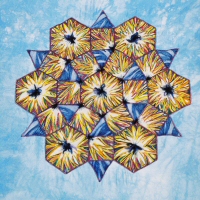
Foot and Mouth
Foot and mouth disease is a devastating disease that affects farm livestock, including pigs and cows. The disease is extremely contagious and spreads rapidly. The outbreak in 2001 forced the closure of much of Britain's countryside for months, seriously affecting tourism and leading to the slaughter of 5 million animals. The disease cost the farming community more than £800 million and set back the tourist industry by up to £3 billion. Animals can be vaccinated against the foot and mouth virus, but up until now the preferred option has been to slaughter animals near an outbreak.
By looking at the structure of the foot and mouth disease virus, scientists can start to develop a new class of drugs called protease inhibitors. These have been very successful in treating HIV and work by stopping the virus from multiplying after infection.
Design taken from image courtesy of Wellcome Trust
Made by Steeple Aston WI

